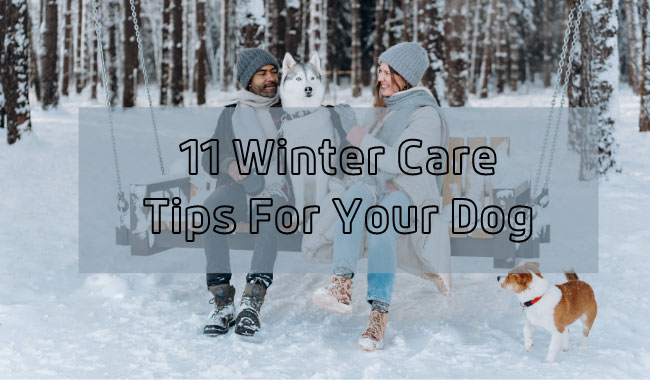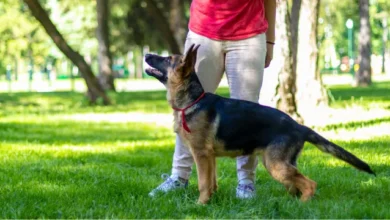
Cold winter months are tough on dogs since their body characteristics differ from the human body, making them more susceptible to cold weather diseases and conditions. To ensure that your dog remains safe during this time of year, there are several things you can do to protect them from the elements like snow, ice, and cold. This article provides several different tips to help you take care of your dog during the winter months.
Read More:
- How to Keep Your Pets Happy and Healthy and Avoid Cold-Weather
- Choosing the Best Dog Sports Gear for Cold Weather Adventures
- Basic Horse Care For Beginners
- 7 Useful Winter Dog Products for Your Teacup Puppy
- 8 Things Every Dog Owner Needs in 2022
#1. Limiting Outdoor Time
Although you might notice your dog loves the snow and cold weather, it is very dangerous for them to be outside during these conditions. This is especially true for smaller breeds. Limit your dog’s outdoor time when the temperature drops below 50 degrees Fahrenheit or 10 degrees Celsius.
Let your dog in when they show signs of shivering or discomfort. The temperature will drop much lower when the sun is down, so start this process early in the day. Ensure the dog has access to a shelter and is dry and well-fed before letting them inside.
#2. Get Pedicures for Your Dog
Just like humans, dogs need to have their nails trimmed regularly. Depending on your dog’s size and activity level, you may need to cut them every few weeks or every month. Trimming your dog’s nails will help keep them from slipping on the ice, especially if they are running or playing.
You can take your dog to a professional groomer for this or learn how to do it yourself. If you decide to clip them at home, be sure to have good lighting and hold their feet firmly against your legs to avoid accidental cuts. If you do not feel comfortable doing this yourself, ask a friend or family member for help.
#3. Use Dog Booties
Like humans, dogs’ feet can get cold during the winter months. This is especially true if they are off the ground (e.g., hiking through snow). Although many dog owners use dog boots as fashion accessories throughout the year, they are critical during cold weather months when your dog’s paws will be exposed for longer periods.
These booties should come up just past your pet’s paw pads and fit snugly so dirt cannot work its way into them. They usually have protection on the top and bottom of each foot. It is important to use dog boots made of material that will provide enough insulation while still allowing them to breathe. Most dogs get used to wearing these booties within a few weeks, so it is worth trying them out.
#4. Use Dog Coats and Sweaters
Some dog apparel is designed for warmth, while others are more fashion-based, like human clothes. Check with your vet or local retailers before you purchase one to know which type would be best for your dog’s breed and temperament. If your dog does not already have hair between their toes, they may need dog boots in addition to the dog hoodie during icy conditions.
The dog hoodie should be easy to put on and take off, especially if the dog lives in a warmer region. These dog apparel are typically made out of fleece or other soft fabrics to help your dog stay warm when the temperatures become chilly.
#5. Make Sure Your Dog’s Food is Safe From Freezing
Dogs’ food needs to have a shallow moisture content, so it does not freeze in the cold. If you find that your dog’s food is frozen in the morning, you can do a few things to help thaw it out.
You can add hot water to their bowl and then pour off any excess once the food has become moist enough for them to eat, or you can put their food into an insulated container overnight next to a warm water source (e.g., near a drain pipe). Whatever method you use, clean your dog’s bowl thoroughly before using it again.
#6. Adjust Feeding Schedules
It may seem inconvenient, but you should only feed your dog on a schedule when the weather is cold. Limit food intake to two or three times per day instead of the six or seven that they are used to eating. This will help keep their digestive system working smoothly while adjusting to being cooped up inside for longer periods.
Be sure to provide plenty of water while inside not to develop an upset stomach. Feeding your dog low moisture food during winter may also help prevent bloat.
#7. Give Your Dog Plenty of Activity During the Day
Just because your dog is cooped up inside does not mean that they should be stuck in bed all day, especially if you have a breed that typically has a lot of energy. Like people, dogs become more lethargic during colder months because they are less active. This can lead to boredom and depression, which may cause your dog to act out.
To prevent this, you should play with your dog indoors for at least one hour per day. If they are used to going outside before winter starts, try doing the same thing inside instead (e.g., taking them to the park or other outdoor location). This way, your dog will still get plenty of activity without worrying about drifting snow or sidewalks covered in ice.
#8. Keep Your Dog’s Paws Warm and Dry
Dogs’ paws are sensitive to extreme temperatures because they do not have sweat glands. Therefore, their paws can become dry and cracked when they contact cold surfaces for too long. When this happens, the risk of injury increases dramatically because your pet will be hesitant to walk or move around freely.
You should wash your dog’s feet once a week during colder months to check them for bacteria or other infections. Although it may seem like keeping the feet clean is unimportant when indoors, never underestimate germs that can develop even within the comforts of home.
To keep your dog’s paws warm and dry during the winter months, you should keep them active both indoors and outdoors as much as possible. If your dog does not have dog boots, you should wipe their feet before going back indoors to ensure that any water outside of their paws does not become ice once they are inside.
#9. Use a Doggy De-Icer in the Yard
If you live somewhere with freezing winters, you must put a de-icer in your outdoor fenced area. This will ensure that no snow or ice is obstructing the gate, so your dog does not accidentally escape while trying to get some fresh air.
Using a product specifically made for pets may help melt away any snow without causing too much moisture near your dog’s food and water bowls.
#10. Use Snuggly Beds and Blankets
If your dog has a bed, but it is not quite warm enough for them during the winter, you should invest in an electric dog bed that will help keep them warm. You can even look for dog heating pads that operate the same way people use (e.g., placing it underneath their blanket). These blankets typically have special wiring to ensure your pet’s comfort all night long.
#11. Keep Your Dog’s Room at a Comfortable Temperature
About four hours before bedtime, you should warm up your dog’s sleeping room as much as possible (e.g., turning on the space heater, setting up an electric blanket, or heating pad). This will help keep them comfortable once they sleep for the night. If you do not take this step before bedtime, your pet could wake up in the middle of the night and need to go outside for a bathroom trip (which may wake you up too).
Conclusion
We have discussed some useful tips on how to take care of your dog during the cold winter months. These include feeding low moisture food during the winter, keeping your dog’s paws warm and dry, using a doggy de-icer in the yard, keeping your pet’s room at a comfortable temperature before bedtime, using snuggly beds and blankets, and playing indoors with your dog for at least one hour per day.




